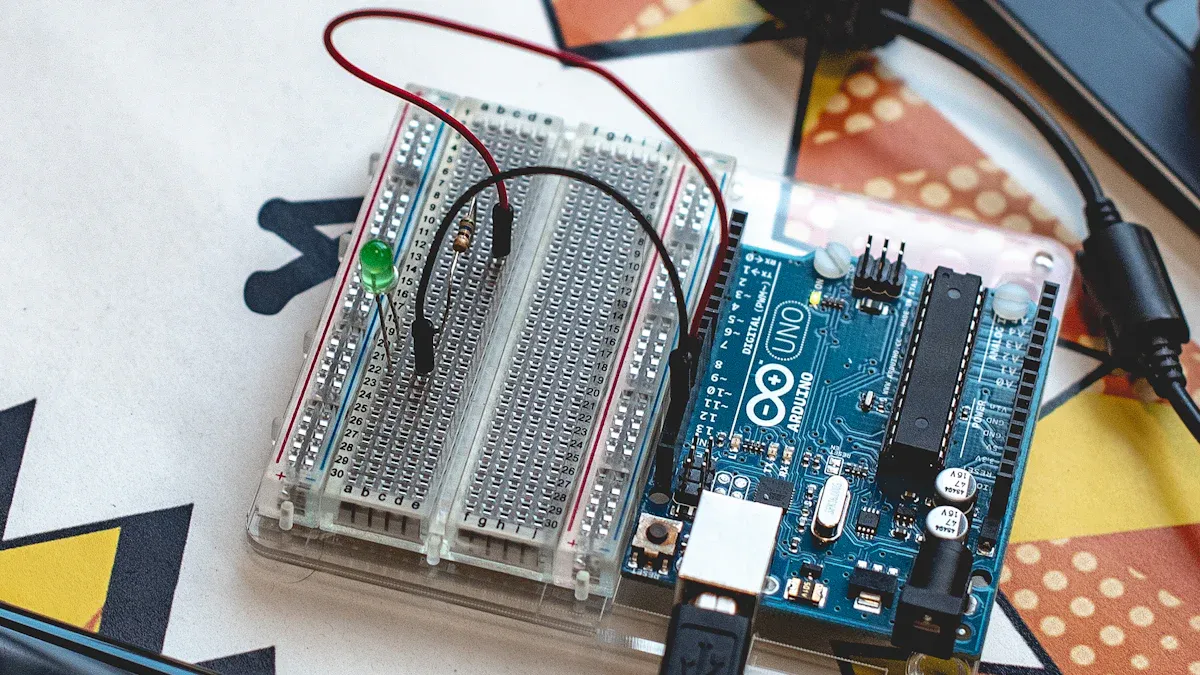How to Choose the Pulse Width Modulation PWM Controller chip You Need

Pulse-width modulation (PWM) is very important in power electronics. It helps control voltage and current efficiently in many devices. The PWM controller market was worth $8.2 billion in 2023. By 2032, it may grow to $12.5 billion. This growth is due to energy-saving needs and better semiconductor technology. PWM controllers are used in LED lights, power chargers, and gadgets.
Two popular PWM controllers are the UC3842 and UC3843. They belong to the UC384x series and have similar features. However, when comparing UC3842 vs UC3843, they differ in voltage lockout levels and design details. Knowing these differences helps you pick the right one for your project. This blog will help you decide between the UC3842 and UC3843 based on what you need.
Key Takeaways
Learn how UC3842 and UC3843 are different. UC3842 works well with high voltage, while UC3843 is better for low voltage.
Look at the UVLO (under-voltage lockout) levels first. UC3842 starts at 16V, and UC3843 starts at 8.5V.
Think about what your project needs. Use UC3842 for factory power systems and UC3843 for battery devices.
Check the pin setup of both controllers. They have the same design, so you can switch them easily.
Always read datasheets for more details. This helps you pick the right PWM controller for your project.
Understanding PWM Controllers

What is PWM
Pulse-width modulation (PWM) controls power sent to devices. It works by turning a signal on and off quickly. The "on" time compared to the full cycle sets the power level. This method saves energy and is used in motors, LED lights, and power supplies. By changing the duty cycle, PWM adjusts voltage and current precisely. This makes it very useful in modern electronics.
Overview of UC3842 and UC3843
The UC3842 and UC3843 are common PWM controllers in the UC384x series. They are made for high-performance power supply systems. These controllers manage voltage and current well, perfect for switch-mode power supplies (SMPS). The UC3842 turns on at 16V and off at 10V, making it good for high-voltage uses. The UC3843 turns on at 8.5V and off at 7.9V, better for low-voltage designs. Both can handle a 100% duty cycle, making them flexible for different setups.
Key Features of UC3842 vs UC3843
The UC3842 and UC3843 are similar but have key differences. The table below shows their main features:
Feature | UC3842 | UC3843 |
|---|---|---|
16V | 8.5V | |
UVLO Threshold (off) | 10V | 7.9V |
Application | High-voltage | Lower voltage |
Frequency | 50 kHz | 50 kHz |
Additional Features | N/A | Soft-start, Overvoltage Protection, Internal Temperature Compensation |
The UC3843 has extra features like soft-start and overvoltage protection. This makes it more useful for some projects. The UC3842 is still great for high-voltage needs because of its higher UVLO levels. Both controllers are efficient and stable, ensuring they work well in power supply designs.
Pinout Analysis of UC3842 and UC3843
UC3843 Pinout and Functions
The UC3843 has eight pins, each with a specific job. The table below explains the pins and their roles:
Pin No. | Pin Name | Description |
|---|---|---|
1 | COMP/Comparator | Gives a signal based on voltage changes. |
2 | VFB/Voltage Feedback | Sends voltage differences to the error amplifier. |
3 | Current Sense | Checks circuit current using a resistor and gives feedback. |
4 | RT/CT | Links to the oscillator, set by a resistor/capacitor. |
5 | GND | Ground connection for the circuit. |
6 | Output | Sends the PWM signal to control devices. |
7 | VCC | Supplies power to the IC. |
8 | VREF | Provides a reference voltage for the circuit. |
The UC3843 helps DC-to-DC converters and offline systems work better. It controls voltage and keeps current steady. It works in both voltage and current modes. This makes it useful for SMPS and battery chargers.
Comparing Pinout Configurations
The UC3842 and UC3843 have the same pin layout. This means they can be swapped in many designs. Both have eight pins with similar tasks. For example, Pin 1 (COMP) and Pin 2 (VFB) manage voltage feedback and error correction. Pin 3 (Current Sense) checks current flow. But, they work at different voltage levels. The UC3842 is for higher voltages, while the UC3843 is for lower ones. This helps designers pick the right one for their needs.
Practical Implications of Pinout Differences
The same pin layout makes designing easier. Engineers can switch between UC3842 and UC3843 without changing the circuit. But, their UVLO thresholds affect performance. The UC3843, with a lower UVLO, is good for low-voltage devices like battery-powered gadgets. The UC3842 works better in high-voltage setups, like industrial power supplies. Knowing these differences helps ensure the best performance for each use.
Circuit Design with UC3842 and UC3843
Voltage and Current Needs
Using the UC3842 and UC3843 needs careful planning. You must check voltage and current limits. These controllers work best in specific ranges. The UC3843 works with 7.6V to 30V supply voltage. The UC3842 usually needs 15V input voltage. Both can handle up to 1A output current. This makes them useful for many power projects.
Parameter | Specification |
|---|---|
Nominal Input Voltage | 15V |
Supply Voltage (Vcc) | 7.6V~30V |
Output Current | 1A |
Matching the controller to the circuit's power is important. The UC3843 is better for low-voltage devices. The UC3842 works well in high-voltage setups like industrial systems.
Stability and Efficiency in Design
Stability and efficiency are key in PWM circuits. The UC3843 keeps voltage steady, even with changing loads. This is important for DC-to-DC converters and power supplies. The UC3842 reacts quickly to load changes. This helps keep the circuit efficient.
Choosing the right PWM frequency affects performance. High frequencies make smoother outputs but can cause more heat and noise. Low frequencies reduce heat but may create sound issues. Designers must balance these factors for the best results.
The UC3843 handles voltage changes well, improving efficiency in converters.
New PWM methods, like variable-frequency PWM, improve control and save energy.
Common Problems and Fixes
PWM circuits can have problems that hurt performance. Issues include voltage errors, timing problems, and resistance mismatches. These can make the PWM signal less accurate and reduce efficiency.
Type of Error | Description | Impact on Performance Statistics and Error Rates |
|---|---|---|
Saturation Errors | Voltage changes under certain loads. | Can make PWM signals less accurate. |
Timing Errors | Changes in signal rise and fall times. | Affects how accurate the PWM signal is. |
Resistance Errors | Uneven resistance in high and low modes. | Causes duty cycle problems, lowering performance. |
To fix these problems, designers can use error correction and better layouts. Good grounding and shorter traces help reduce timing issues. Using quality parts also keeps performance steady, especially in power supplies.
Choosing Between UC3842 vs UC3843
How to Decide Which to Use
Picking the right PWM controller depends on your project needs. The UC3842 and UC3843 have similar features but differ in key ways. These include their voltage ranges and UVLO (under-voltage lockout) levels. These differences make them better for different tasks.
Feature | UC3842 | UC3843 |
|---|---|---|
Operating Voltage Range | High-voltage applications | Lower voltage applications |
UVLO Threshold (On) | 16V | 8.5V |
UVLO Threshold (Off) | 10V | 7.9V |
Maximum Duty Cycle | 100% | 100% |
The UC3842 works best in high-voltage systems like industrial power supplies. Its higher UVLO levels make it reliable for these uses. The UC3843 is better for low-voltage devices, such as battery-powered gadgets. Its lower UVLO levels suit portable electronics. Both controllers can run at a 100% duty cycle, making them flexible for many designs.
Examples of Where to Use Them
Looking at real-world uses can help you decide. For example:
UC3842: This is great for industrial tools needing high-voltage power. It works well in flyback converters and DC-to-DC converters for heavy equipment.
UC3843: This is ideal for small, battery-powered devices. It’s perfect for gadgets, LED lights, and low-power chargers.
Both controllers manage voltage and current well. However, their unique features make them better for specific jobs.
Tips for Picking the Right Controller
Here are some tips to help you choose between the UC3842 and UC3843:
Check Voltage Needs: Know your system's voltage range. Use UC3842 for high voltage and UC3843 for low voltage.
Look at Current Levels: Make sure the controller can handle the needed current.
Think About the Application: Match the controller to your device. Use UC3843 for portable gadgets and UC3842 for industrial systems.
Verify Pin Layout: Both controllers have the same pin layout. This makes swapping them easy, but check if the one you pick fits your design.
Read the Datasheets: Always review datasheets for detailed specs and advice.
By following these tips, you can pick the best PWM controller for your project. This ensures your design works efficiently and reliably.
Deciding between the UC3842 and UC3843 means knowing their differences. The UC3842 works best in high-voltage systems. The UC3843 is better for low-voltage devices. The table below shows their main differences:
Feature | UC3842 | UC3843 |
|---|---|---|
UVLO On Threshold | 16V | 8.5V |
UVLO Off Threshold | 10V | 7.9V |
Maximum Duty Cycle | 100% | N/A |
Application Focus | High-voltage applications | Lower voltage applications |
Control Mode | N/A | Voltage and current modes |
Knowing the pin setup and circuit design is also important. Features like current-mode control help save energy and improve power use. The table below explains these features:
Feature | Description |
|---|---|
Current-mode control | Keeps power steady and reduces energy waste. |
Pin configuration | Clear layout helps in building good circuits. |
Applications | Useful for managing power in tools and gadgets. |
Reading datasheets gives more details about the UC3843 and others. Testing designs can improve results and find the best match for your needs.
What is the main difference between UC3842 and UC3843?
The biggest difference is their UVLO (under-voltage lockout) levels. The UC3842 works with higher voltages (16V on, 10V off). The UC3843 is made for lower voltages (8.5V on, 7.9V off). This makes them fit for different power designs.
Can UC3842 and UC3843 be swapped in circuits?
Yes, they have the same pin layout, so swapping is easy. But their UVLO levels are different, so check your voltage needs first. Always make sure the circuit matches the controller's specs before switching.
What are the best uses for UC3842?
The UC3842 is great for high-voltage systems like industrial power supplies. It also works well in flyback converters. Its higher UVLO levels make it reliable for tough voltage needs.
Why is current-mode control useful in PWM controllers?
Current-mode control helps keep circuits steady and quick to respond. It watches current flow to manage voltage better. This saves energy and works well in devices needing exact power control, like DC-DC converters.
How can designers fix common PWM circuit problems?
Designers can fix problems like timing or voltage errors by improving layouts. Use shorter wires, good grounding, and quality parts to reduce mistakes. Checking datasheets and testing designs also helps make circuits work better.
CALL US DIRECTLY
(+86)755-82724686
RM2508,BlockA,JiaheHuaqiangBuilding,ShenNanMiddleRd,Futian District,Shenzhen,518031,CN
www.keepboomingtech.com sales@keepboomingtech.com
